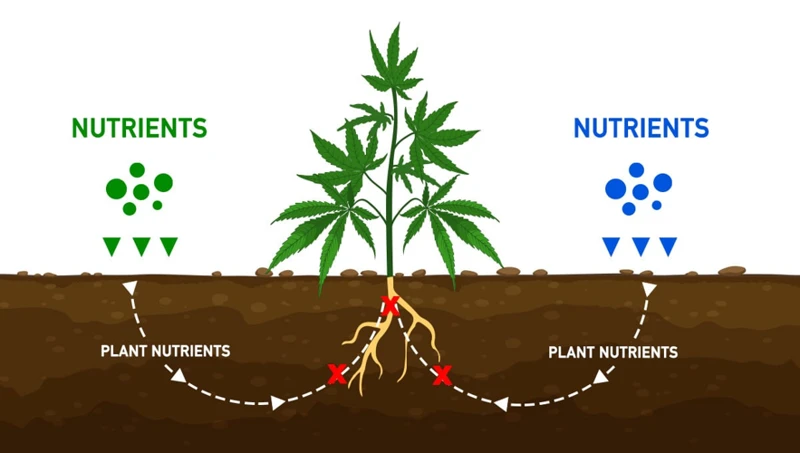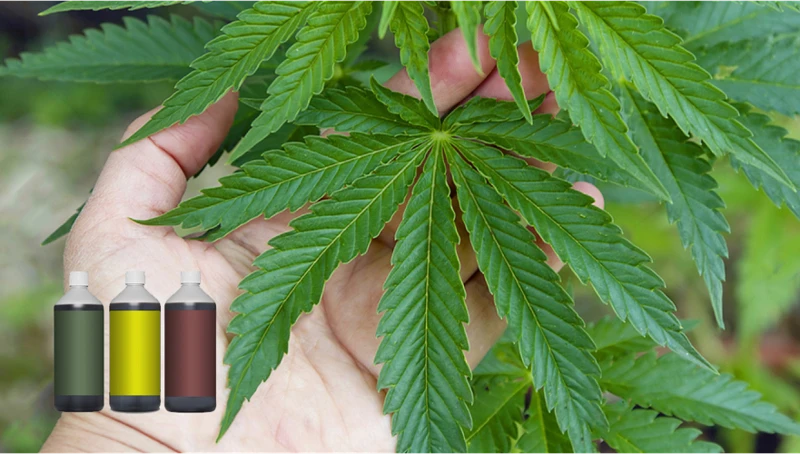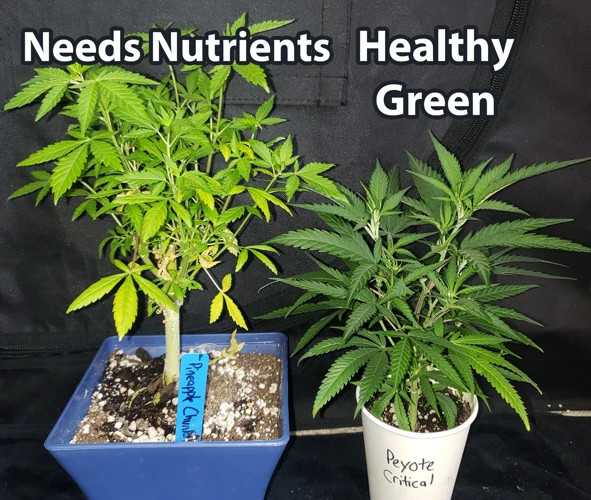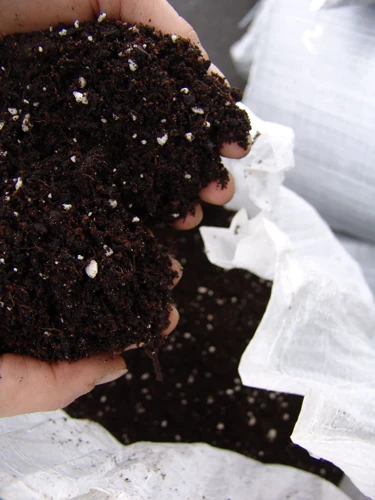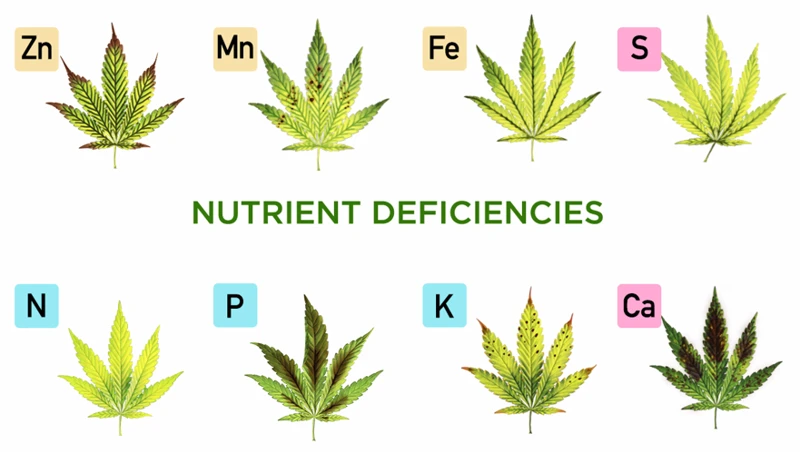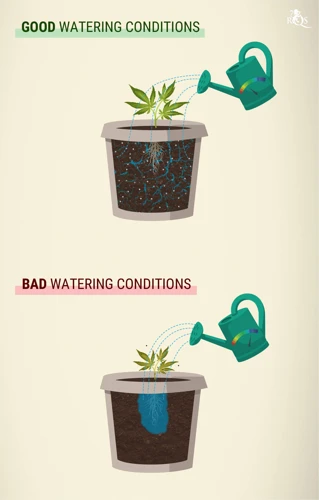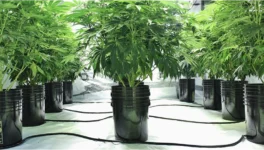
Common Mistakes to Avoid When Feeding Your Cannabis Plants Organically
As a cannabis grower, you want to maximize the potential of your plants, getting the best yield possible. While feeding your cannabis plants organically is a great way to avoid exposing yourself and the end-user to harmful chemicals, there are some common mistakes that can negatively impact your crop. From choosing the right soil to recognizing the signs of toxicity and deficiency, there are several factors to consider. In this article, we will guide you through the process of feeding your cannabis plants organically, step-by-step, to ensure a healthy crop and a bountiful yield.
Choosing the Right Soil
Contents
As a cannabis grower, choosing the right soil for your plants is essential for a successful harvest. However, with so many types of soil available, it can be overwhelming to know which one is best for your specific needs. Using Rich Soil is Not Always the Best Option, even though it may seem logical to use soil that is packed with nutrients. Similarly, Soil with Poor Drainage Can be Harmful for your Crop and may lead to root rot or other issues. In this section, we’ll explore the considerations you should make when selecting soil for your organic cannabis crop.
Using Rich Soil is Not Always the Best Option
When it comes to growing cannabis, many people believe that using rich soil is always the best option. However, this is not always the case. While nutrient-rich soil can provide your plants with the essential nutrients they need, it can also lead to nutrient burn and root rot if not used correctly.
Using rich soil that is too high in nutrients can cause an overabundance of minerals to accumulate in the soil. This can cause damage to your plants and can even make them more susceptible to disease. On the other hand, soil that is low in nutrients can lead to nutrient deficiencies in your plants, which can also be harmful to their growth and development.
To avoid these issues, it is essential to choose soil that is tailored to your plant’s needs. This means that you need to consider the nutrient requirements of your specific cannabis strain, as well as the growing conditions in your particular environment. Testing the pH level of your soil can also help you determine the optimal nutrient levels for your plants.
In addition to nutrient levels, it is also essential to consider the drainage of your soil. Soil with poor drainage can lead to waterlogged roots, which can suffocate your plants and ultimately lead to their demise. It is crucial to choose soil that is well-draining and porous enough to allow for adequate oxygen and water flow.
While using rich soil can be beneficial for your cannabis plants, it is not always the best option. It is crucial to use soil that is tailored to your plant’s needs, considering their nutrient requirements and your environment’s growing conditions. By doing so, you can help ensure that your plants grow healthy and strong, without succumbing to nutrient burn or root rot.
| Pros of Rich Soil | Cons of Rich Soil |
|---|---|
| Provides essential nutrients | Can lead to nutrient burn |
| Can improve plant growth and yield | Can increase risk of disease |
| Can improve soil structure | Can be expensive |
Soil with Poor Drainage Can be Harmful for your Crop
When it comes to feeding your cannabis plants organically, choosing the right soil is crucial. However, it’s not just about choosing a soil that is rich in nutrients. Another important factor you need to consider is the drainage of the soil. Soil with poor drainage can have a negative impact on your crop.
Here are some reasons why poor drainage can harm your cannabis plants:
- Root Rot: When water cannot drain out of the soil quickly enough, it can lead to root rot in your plants. This is because the excess water creates an oxygen-deprived environment, which can promote the growth of harmful bacteria and fungi that attack the roots of the plant.
- Nutrient Deficiencies: Poorly drained soil can also lead to nutrient deficiencies in your plants. When water cannot drain out properly, the roots may not be able to absorb nutrients effectively, leading to stunted growth and other problems.
- Stressed Plants: Cannabis plants that are growing in soil with poor drainage may become stressed and show signs of wilting or yellowing leaves. This can also make them more vulnerable to pests and diseases.
To avoid these problems, it’s important to choose soil that has good drainage. One way to do this is to look for soil that contains ingredients like perlite, vermiculite, or sand, which can help improve drainage. Additionally, make sure to use containers that have drainage holes to allow excess water to escape.
By paying attention to the drainage of your soil, you can ensure that your cannabis plants are healthy and thriving. Remember, feeding your plants organically is a holistic process, and every aspect of the growing environment plays a role in their overall health and vitality.
Overfeeding and Underfeeding
One of the biggest mistakes that many cannabis growers encounter is providing incorrect nutrients to their plants. Providing too much or too little of the essential nutrients can cause a range of problems, which can affect the overall yield and potency of your cannabis crop. Getting the right balance with nutrients can be challenging, but it’s an essential part of growing healthy cannabis plants organically. In this section, we’ll explore the signs of overfeeding and underfeeding, how to prevent these issues, and tips for maintaining the right balance of nutrients.
Signs of Overfeeding and Underfeeding
Understanding the signs of overfeeding and underfeeding is crucial for a successful organic cannabis crop. Overfeeding can cause nutrient toxicity, which can damage and even kill your plants. Underfeeding, on the other hand, will result in nutrient deficiencies, which will also negatively impact your plant’s growth and yield. The following table summarizes the key signs of overfeeding and underfeeding:
| Signs of Overfeeding: | Signs of Underfeeding: |
|---|---|
| Leaf tips curling downwards | Yellowing of leaves |
| Burnt or crispy leaves | Slow growth |
| Leaf edges turning brown | Poor bud development |
| Brown or yellow spots | Stunted growth |
| Dark green leaves | Weak stems |
| Unusual leaf colors (e.g. purple, red) | Small leaves |
It is important to closely monitor your plant’s growth and appearance to ensure that they are receiving the proper amount of nutrients. If you notice any of the signs listed above, take action immediately to correct the issue. This may involve flushing your soil to remove excess nutrients or adjusting your nutrient feeding schedule to ensure your plants are receiving the proper balance of nutrients. Remember, maintaining a healthy level of nutrients is key for a successful organic cannabis crop.
Prevent Overfeeding and Underfeeding by Maintaining Crop Health
Nutrient balance is key to maintaining crop health and preventing overfeeding or underfeeding. It is important to track nutrient intake and overall plant health to ensure the cultivation process is moving in the right direction. Consider the following table to highlight ways to prevent overfeeding and underfeeding and maintain crop health:
| Preventing Overfeeding: | Preventing Underfeeding: |
| 1. Use soil with good drainage to prevent nutrient build-up | 1. Test soil regularly to ensure pH and nutrient levels are balanced |
| 2. Avoid excessive fertilization and only apply nutrients as needed | 2. Monitor plant growth for signs of nutrient deficiency and adjust accordingly |
| 3. Choose organic fertilizers to provide natural and balanced nutrient sources | 3. Incorporate nutrient-dense compost materials into the soil |
| 4. Avoid synthetic pesticides, herbicides and fertilizers that can damage the crop and soil health | 4. Use supplements like fish emulsion or kelp meal to increase nutrient availability |
| 5. Observe plant growth and overall health to determine nutrient needs and adjust fertilization rates as required | 5. Ensure plant roots receive ample airflow and are not compacted in soil |
Following these practices can help maintain crop health and prevent overfeeding or underfeeding. By providing the right balance of nutrients in healthy soil with good drainage and proper pH levels, your cannabis plants will thrive and produce a quality crop.
Don’t Skip Critical Nutrients and Maintain the Right Balance
When growing cannabis plants organically, it is crucial to ensure that they receive all the essential nutrients in the right balance. Skipping any of these nutrients can lead to deficiencies that can harm the growth and health of your plants. Here are some of the critical nutrients that you should not skip when feeding your cannabis plants:
| Nutrient | Function | Deficiency Signs |
|---|---|---|
| Nitrogen | Essential for vegetative growth, photosynthesis, and protein synthesis | Yellowing leaves, stunted growth, and reduced yields |
| Phosphorus | Important for root development, flowering, and fruiting | Purple leaves, weak stems, and poor bud development |
| Potassium | Crucial for overall plant health, stress tolerance, and flower development | Leaf tip burn, slower growth, and reduced yields |
| Calcium | Important for cell wall development and structure | Leaf tip burn, stunted root growth, and blossom end rot |
| Magnesium | Essential for chlorophyll production and energy metabolism | Yellowing leaves that start from the middle of the plant |
Maintaining the right balance of these nutrients is also crucial. Overfeeding or underfeeding any of them can lead to toxicity or deficiency issues, which can harm your plants. Using organic fertilizers that provide a balanced ratio of these nutrients is an excellent way to ensure that your cannabis plants receive all the essential elements they need.
Regularly monitoring your plants for any signs of nutrient deficiencies or toxicity is also critical. This can help you catch any issues early and rectify them before they cause significant damage. Additionally, caring for your plants’ overall health can help prevent nutrient-related issues from arising.
Choosing the Right Fertilizers
When it comes to feeding cannabis plants organically, choosing the right fertilizers can be perplexing. There are so many options available, each boasting its unique benefits, that it can be challenging to determine which to pick. However, using the right fertilizers is essential to ensure your plants receive the necessary nutrients. Organic fertilizers are a great option to fulfill your plants’ needs and promote healthy growth, while synthetic fertilizers can potentially harm your plants and the environment. In this section, we will explore the benefits of organic fertilizers and why it’s crucial to avoid synthetic fertilizers, pesticides, and herbicides.
Organic Fertilizers – A Great Option for Cannabis
When it comes to fertilizing your cannabis plants, it’s important to choose the right type of fertilizer to ensure healthy growth and abundant yields. Organic fertilizers are a great option for those who want to grow cannabis plants naturally without introducing synthetic chemicals.
Organic fertilizers are made from natural sources such as plant and animal waste, bone meal, and sea kelp. They work by slowly releasing nutrients into the soil, providing a steady supply of food for your plants over time. This slow-release process is important because it reduces the risk of over-fertilization, which can be harmful to your plants.
One benefit of using organic fertilizers is that they promote the growth of beneficial microbes in the soil. These microbes help to break down organic matter and make nutrients more available to your plants. Additionally, organic fertilizers improve soil structure and water retention, which can lead to healthier plants.
Here is a table comparing organic fertilizers with synthetic options:
| Organic Fertilizers | Synthetic Fertilizers |
|---|---|
| Slow-release nutrients, which reduce the risk of over-fertilization | Fast-acting, which can lead to over-fertilization and nutrient burn |
| Promote beneficial microbial activity in the soil | Can harm beneficial soil microbes |
| Improve soil structure and water retention | Do not improve soil structure, may even degrade it over time |
| Derived from natural sources such as animal and plant waste, bone meal, or sea kelp | Are usually chemically synthesized |
In conclusion, organic fertilizers are a great option for those who want to grow cannabis naturally and without the use of synthetic chemicals. They promote healthy plant growth and a healthy soil environment, which can lead to bigger yields and better quality cannabis.
Avoid Synthetic Fertilizers, Pesticides and Herbicides
Using synthetic fertilizers, pesticides, and herbicides can have harmful effects on both the environment and cannabis plants. While they may offer quick results, they can lead to long-term damage to the soil and the plants themselves.
Why Avoid Synthetic Fertilizers? Synthetic fertilizers are made with chemicals that can harm microorganisms in the soil, which are essential for plant growth. Over time, synthetic fertilizers can lead to soil depletion, making it difficult for plants to absorb nutrients naturally.
Why Avoid Pesticides and Herbicides? Many pesticides and herbicides contain harmful chemicals that can get absorbed by the cannabis plant, leaving behind toxic residues. These residues can also find their way into the water supply and harm wildlife.
To avoid these harmful effects, it’s best to use organic fertilizers, pesticides, and herbicides. Organic fertilizers use natural ingredients like bat guano, bone meal, and worm castings to provide nutrients to the soil, improving the overall health of the soil and the crops.
Organic pesticides and herbicides can also provide effective pest control without the harmful side effects of their synthetic counterparts. These products often contain natural ingredients such as garlic, neem oil, and peppermint oil, which have fewer harmful effects on the surrounding environment.
When using organic fertilizers, pesticides, and herbicides, consult with a knowledgeable professional to ensure proper use and application. It’s important to choose products that are tailored to your specific needs and the needs of your cannabis plants.
By avoiding synthetic fertilizers, pesticides, and herbicides, you’ll be taking a step towards a healthier and more sustainable environment for both your cannabis plants and the world around you.
Using the Right Amount of Nutrients
One of the biggest mistakes that novice cannabis growers make is over or underfeeding their plants. Achieving the right balance of nutrients is crucial to producing successfully grown and healthy plants. However, it can be perplexing to know exactly how much to feed your plants, and how often. In this section, we will explore various techniques for determining the correct amount of nutrients to feed your plants, including starting slow and gradually increasing, using water quality reports, and using supplements to improve nutrient availability. It is important to get the balance right, as too much or too little can lead to negative implications.
Start Slow and Increase Gradually for Best Results
One of the most important things to keep in mind when feeding cannabis plants organically is to start slow and gradually increase the amount of nutrients. This is to avoid overwhelming the plants with too much too soon. Here are some tips to keep in mind:
- Start with a low amount of nutrients: When you first start feeding your plants, it’s best to begin with a small amount of nutrients and gradually increase over time. This will allow the plants to adjust to the new nutrients and prevent overfeeding.
- Observe plant growth: Keep a close eye on the growth of your plants. If they are growing too fast or too slow, it could be a sign that you need to adjust your nutrient levels.
- Carefully measure the nutrients: Proper measurement of nutrients is important to avoid accidentally overfeeding your plants. Use measuring spoons or a scale to precisely measure out the appropriate amount of nutrients.
- Adjust based on plant needs: As your plants grow and develop, their nutrient needs may change. Keep an eye on their growth and adjust the feeding accordingly.
By starting slow and gradually increasing the amount of nutrients, you can help ensure the best possible results for your cannabis plants. Remember to carefully monitor your plants and adjust the feeding as needed to ensure their optimal growth and health.
Get a Water Quality Report Before starting
Testing the quality of the water that you use to irrigate your cannabis plants can be crucial to the success of your grow. Before you start, it is recommended that you get a water quality report from your local water supplier or use a water testing kit. This will help you understand the level of minerals, salts, and other contaminants in your water which can affect the health of your plants.
A water quality report typically includes information about pH and mineral content. Here are some of the important factors you should pay attention to when reviewing your water quality report:
| Parameter | Acceptable Range | Impact on Plants |
|---|---|---|
| Conductivity (EC) | 0.2 – 0.8 mS/cm | High levels can cause nutrient lockout and plant stress. |
| pH | 6.0 – 7.0 | Low or high pH can limit the availability of nutrients. |
| Total Dissolved Solids (TDS) | 50 – 200 ppm | High TDS can cause nutrient burn and toxicities. |
| Chlorine | 0 ppm | Chlorine can be toxic to plants, and should be removed. |
| Alkalinity | 40 – 80 ppm | Low alkalinity can result in pH fluctuations. |
| Hardness | 50 – 200 ppm | High hardness can cause nutrient deficiencies. |
Once you have an idea of the water quality you are working with, you can adjust your nutrient regimen to the specific needs of your plants. For instance, if your water is high in dissolved solids, you may want to adjust your nutrients down to avoid overfeeding your plants. Alternatively, if your water is particularly soft (low in dissolved solids), you may need to add additional nutrient supplements to ensure your plants get the necessary elements to grow healthy and strong.
Regularly testing and monitoring your water quality can help maintain optimal plant health and prevent issues that may arise from poor water quality. Remember that even minor changes in water quality can have an impact on your crop. Getting a water quality report and understanding the results can go a long way in producing a successful organic cannabis grow.
Use Supplements to Boost Nutrient Availability
Growing cannabis plants organically can be challenging, one of the biggest challenges being maintaining proper nutrient balance. Soil naturally contains a finite amount of nutrients and your plants will only be able to take up what’s available. This can lead to nutrient deficiencies or imbalances, which can harm your plants. However, there are supplements available that can help boost nutrient availability, allowing your plants to absorb more of what they need. Here are some ways to use supplements to boost nutrient availability:
- Use Compost Tea: Compost tea is made by steeping compost in water, which creates a liquid rich in nutrients and beneficial microorganisms. Instead of watering your plants with plain water, use compost tea to deliver an extra boost of nutrients
- Add Mycorrhizae Fungi: Mycorrhizae fungi form a symbiotic relationship with the roots of your plants, helping to break down nutrients in the soil and boost nutrient uptake. You can purchase mycorrhizae fungi as a powder to add to your soil or use a mycorrhizae-rich planting mix.
- Use Kelp Meal: Kelp meal is a natural fertilizer that’s high in potassium and other micronutrients. Adding kelp meal to your soil can help boost nutrient availability and promote healthy growth.
- Incorporate Worm Castings: Worm castings are the waste produced by earthworms and are rich in nutrients and beneficial microorganisms. Adding worm castings to your soil can help improve nutrient availability and soil structure.
- Add Bat Guano: Bat guano is a natural fertilizer that’s high in nitrogen, phosphorus, and potassium. Adding bat guano to your soil can help boost nutrient availability and promote healthy growth.
Using supplements to boost nutrient availability is a great way to ensure your cannabis plants get the nutrients they need for optimal growth and health. Incorporating these supplements into your organic growing practices can help you achieve a bountiful harvest.
Careful Management of pH Levels
When it comes to growing healthy cannabis plants, maintaining proper pH levels in the soil is crucial. The pH level of your soil can impact the availability of nutrients and the ability of roots to absorb them. It’s important to stay vigilant and keep the pH level in the recommended range to promote optimal growth and prevent potential issues. In the following section, we will delve into the importance of pH balance in your soil and provide tips on how to manage it carefully.
The Importance of pH Balance in your Soil
Maintaining the correct pH balance in the soil used to grow cannabis plants is crucial for the overall health and growth of the plants. Here are some reasons why this is so important:
1. Nutrient Absorption: When the pH levels of the soil are within the appropriate range, the plants can effectively absorb the nutrients they need. If the pH levels are too high or too low, the plants may not be able to access certain nutrients, leading to deficiencies.
2. Microbial Activity: Soil that is too acidic or too alkaline can also affect the activity of beneficial microbes in the soil. These microbes play an important role in breaking down organic matter and making nutrients available to the plants.
3. Disease Resistance: Cannabis plants that are grown in soil with the proper pH balance are also better equipped to resist diseases and pests. pH levels that are too high or too low can weaken the plants, making them more susceptible to disease.
4. Yield: The pH levels of the soil can also impact the yield of your cannabis crop. When the pH balance is optimal, you can expect to see healthy, robust plants that produce a larger yield.
To maintain the appropriate pH balance, it is recommended to test the soil regularly, especially before adding any new amendments or fertilizers. The ideal pH range for cannabis plants is between 6.0 and 7.0. If the pH levels are outside of this range, consider using organic materials like compost or sphagnum peat moss to adjust the pH.
It is important to note that the pH levels can also vary depending on the type of soil used. For example, soilless mixes may require a different pH balance compared to traditional soil mixes. It is important to understand the recommended pH range for the specific type of soil you are using.
By maintaining the proper pH balance, you can help your cannabis plants thrive and produce high-quality yields.
Use pH Testers to Monitor and Keep Soil in the Right Range
To ensure optimum growth and avoid nutrient-related problems when growing cannabis organically, it’s crucial to monitor and maintain the pH level of your soil. Using pH testers is a simple and effective way to achieve this. Here are a few tips on how to use pH testers to keep your soil in the right range:
- Invest in a Quality pH Tester: There are many types of pH testers available in the market, but it’s important to invest in a quality tester that gives accurate readings. Choose a pH meter that has a long battery life, a digital display, and is easy to calibrate.
- Test Soil at the Right Depth: It’s essential to test the pH level of your soil at the correct depth to get the most accurate reading. Most pH testers require you to take a soil sample 2-3 inches deep and mix it with a distilled water solution before testing.
- Adjust pH as Needed: Once you have tested the pH level, use organic products such as dolomite lime or compost to adjust the pH of your soil. If the pH level is too acidic (below 6.0), add dolomite lime to raise the pH level. If the pH level is too alkaline (above 7.0), add compost to lower the pH level.
- Re-test Regularly: pH levels in soil can change over time, so it’s important to regularly re-test to ensure that the pH level is still within the optimal range. Depending on the type of plants you are growing, re-testing can be done monthly or every few months.
- Maintain the Right pH Range: Depending on the type of organic fertilizers you are using, the optimal pH range for your soil should be between 6.0 to 7.0. When the pH level is in the right range, your cannabis plants will be able to absorb nutrients effectively, leading to healthy growth and a high-quality crop.
By using pH testers to monitor and maintain the pH level of your soil, you can ensure that your cannabis plants are receiving the proper nutrients they need to grow strong and healthy. Make sure to test the soil at the right depth, invest in a quality pH tester, and adjust pH levels as needed to keep your soil in the optimal range.
Recognize the Signs of Toxicity and Deficiency
As a grower, it is important to keep a watchful eye on your cannabis plants to catch any signs of potential issues early on. One major issue that can arise is a nutrient imbalance, causing either toxicity or deficiency in your plants. Learning to recognize these signs can save your crop from irreversible damage. In this section, we will discuss the telltale signs of both toxicity and deficiency and the steps you can take to prevent these issues from occurring.
Common Signs That Your Plants May Have Toxicity or Deficiency Issues
When growing cannabis plants organically, it is critical to regularly inspect them for signs of both toxicity and deficiency. These issues can arise due to various factors such as improper soil pH levels or nutrient imbalances. Below are some common signs that your plants may be experiencing toxicity or deficiency:
| Issue | Signs |
| Toxicity | Yellowing and browning of leaves, burnt tips, stunted growth, spots on leaves |
| Deficiency | Yellowing and browning of leaves, stunted growth, wilting, curled leaves, spots on leaves |
It is important to note that some signs of toxicity and deficiency may appear similar, so it is crucial to diagnose the problem accurately to provide the right solution. Toxicity symptoms often begin at the tips of the leaves and gradually move towards the center, while deficiency symptoms can occur throughout the entire plant.
To prevent toxicity and deficiency, it is important to maintain proper soil pH levels and nutrient balance. This can be achieved by following proper feeding schedules, using the right fertilizers, and monitoring the plants regularly. By recognizing these signs early on, you can prevent damage to your crops and ensure that they grow healthy and yield a bountiful harvest.
Prevent Toxicity and Deficiencies by Regularly Inspecting Plants
Regular inspection of cannabis plants is necessary to prevent any potential toxicity or deficiency issues. By detecting and addressing these problems early, you can ensure healthy growth and a bountiful harvest. Here are some steps you can take to regularly inspect your plants:
| Step 1 | Observe the plants closely for any abnormal growth, discoloration, or wilting. |
| Step 2 | Check the pH levels of the soil regularly to ensure that the plants are receiving the proper nutrients. |
| Step 3 | Monitor the plants’ leaves for signs of nutrient deficiencies, such as yellowing or browning. |
| Step 4 | Examine the plants’ roots for any signs of root rot, such as dark or mushy roots. |
| Step 5 | Check for any pests or diseases on the plants. Look for physical damage, presence of pests, or any signs of abnormalities. |
By regularly inspecting your cannabis plants and taking necessary actions, you can prevent potential issues and ensure a fruitful harvest. Remember that each plant is unique in its growth and development, so a watchful eye is critical to keep them healthy.
Clean Water is Critical
As an organic cannabis grower, one of the most important aspects of maintaining a healthy and thriving crop is providing it with clean water. The quality of the water you use can impact the overall health of your plants and the quality of the final product. Water that is contaminated with toxins or other harmful substances can lead to stunted growth, weakened immune systems, and reduced yields. It is crucial to know how to choose and use water filters to remove contaminants and ensure that your plants are getting the cleanest water possible. In this section, we’ll discuss the importance of clean water in growing organic cannabis and provide practical tips on how to achieve it.
Importance of Clean Water in Growing Organic Cannabis
Growing organic cannabis requires attention to detail and a commitment to supplying your plants with the best possible care. One often overlooked aspect of growing organic cannabis is the importance of clean water.
Clean water is absolutely critical for the health and vitality of your plants because it allows them to maximize the use of nutrients and minerals from the soil, which is instrumental in producing high-quality yields.
Here are some important reasons why clean water is crucial in growing organic cannabis:
- Contaminants can harm your plants: The presence of contaminants such as bacteria, viruses or fungi in your water supply can be extremely damaging to your plants. These microorganisms can lead to fungal diseases, root rot, or damage to your plants’ leaves or stems.
- Water impurities can alter soil PH and nutrient uptake: The presence of impurities in your water supply can alter the natural balance of your soil PH causing it to become too acidic or too alkaline, making it difficult for your plants to absorb the necessary nutrients they need for their growth.
- Prevent mineral buildup: Over time, purified water reduces the risk of mineral buildup in your soil. Minerals can accumulate in the soil and damage your plants, limiting their growth and production. By starting with clean water, you can ensure that your plants receive all the minerals they need without the risk of overburdening the soil.
By making sure that the water you use for your organic cannabis plants is free of contaminants, you can give your plants a better chance to grow healthy and strong. Using water filters, adding water purifying agents, or boiling water for a short period of time can all help to purify your water source.
Make sure to use clean, purified water for your organic cannabis plants to keep them healthy and free from contaminants. By understanding the importance of clean water and ensuring that you provide it to your plants, you can give them the care they need to thrive and produce high-quality yields.
How to Choose and Use Water Filters to Remove Contaminants
When it comes to growing organic cannabis, using clean water is critical for the health and growth of your plants. Contaminated water can lead to a host of problems, including nutrient deficiencies and toxic buildup. Thus, it’s essential to choose and use water filters to remove any contaminants.
Types of Water Filters
There are several types of water filters available on the market. The best filter for you depends on the specific problems with your water. The most common types of water filters include:
| Filter Type | Uses |
|---|---|
| Activated carbon filters | Removes chlorine, pesticides, and other chemicals |
| Reverse osmosis filters | Removes minerals, bacteria, and other contaminants |
| Ultraviolet (UV) filters | Kills bacteria, viruses, and other microorganisms |
| Distillation filters | Removes minerals, metals, and other contaminants |
Choosing the Right Filter
Choosing the right filter depends on what contaminants are in your water. If you know or suspect certain contaminants, research which filters are most effective at removing those specific contaminants. It’s also essential to choose a filter that can handle the amount of water you need.
Using a Water Filter
Once you’ve selected a water filter, follow the manufacturer’s instructions for installation and maintenance. Typically, the filter will need to be changed or cleaned regularly to ensure it’s working correctly. To determine when to change the filter, consider the manufacturer’s recommended lifespan of the filter or use a TDS (total dissolved solids) meter to test the water. When the filter has reached the end of its lifespan or is no longer effectively removing contaminants, it’s time to replace or clean it.
By using water filters to remove contaminants, you can ensure that your cannabis plants are growing in a healthy and pure environment. Remember to choose the right filter based on the contaminants in your water and to follow the manufacturer’s instructions for installation and maintenance.
Proper Drainage is Essential
One crucial yet often overlooked aspect of growing cannabis plants organically is ensuring proper drainage. Without adequate drainage, your crop can experience a range of problems that can cause stunted growth, root rot, and even plant death. As organic growing methods rely heavily on maintaining a healthy soil ecosystem, it’s imperative to understand why proper drainage is essential and take steps to address any issues that may arise. In this section of the article, we will examine the signs of poor drainage and explore strategies to improve it.
Signs of Poor Drainage in Your Soil
When it comes to growing cannabis plants organically, poor drainage in your soil can have detrimental effects on your crop. It’s important to know the signs of poor drainage in order to address the issue before it becomes a major problem. Here are a few indicators to look out for:
- Standing Water: If you notice puddles of water forming around your plants after watering, it may be a sign of poor drainage.
- Soggy Soil: Similarly, if your soil feels overly moist and has a spongy texture, that may be an indicator of poor drainage.
- Yellowing Leaves: Plants with poor drainage can also develop yellowing leaves or other signs of nutrient deficiencies, as the roots are not getting the oxygen and nutrients they need.
- Mold and Mildew: Poor drainage can create a damp environment that is conducive to mold and mildew growth, which can harm your plants and even cause health problems for you.
If you notice any of these signs, it’s important to address the issue quickly in order to prevent further damage to your plants. One solution is to improve the drainage in your soil by adding organic matter such as compost, which can improve the structure and water-retention capacity of your soil. You can also consider using raised beds or containers with drainage holes to ensure proper drainage. Addressing poor drainage is an essential step in growing healthy and thriving cannabis plants organically.
Choose Containers with Drainage Holes or Use Other Techniques to Improve Drainage
When it comes to drainage in your cannabis grow, it’s important to ensure that water can move freely through your soil. One way to achieve this is by choosing containers with drainage holes. These holes will allow excess water to drain out of the soil, preventing root rot and other issues. But what if your containers don’t have drainage holes? Don’t worry, there are still other techniques you can use to improve drainage.
One option is to add a layer of rocks or gravel at the bottom of your container. This helps create space between the soil and the container, allowing water to collect at the bottom and drain away from the roots. Another option is to use a perlite or vermiculite in your soil mix. These materials improve drainage and aeration, which can help your plants grow healthier and produce better yields.
If you’re growing outdoors, you can also use raised beds or hugelkultur (a technique where you bury logs and other organic matter under soil) to promote better drainage. These methods elevate your plants above the surrounding soil, which helps water drain more effectively.
Whatever method you choose, it’s important to regularly monitor your soil moisture levels and adjust your watering practices accordingly. Overwatering can be just as damaging as underwatering, so make sure that your soil is only slightly moist and not saturated. By taking steps to improve drainage in your cannabis grow, you’ll help your plants thrive and produce the best possible yields.
| Techniques for Improving Drainage | Advantages | Disadvantages |
|---|---|---|
| Choosing containers with drainage holes | Easy to implement, relatively inexpensive | May not be suitable for all container types, may require additional drainage materials |
| Adding a layer of rocks or gravel to the bottom of containers | Creates space between soil and container, relatively easy to implement | May not be suitable for all container types, could add weight to containers |
| Using perlite or vermiculite in soil mix | Improves drainage and aeration, suitable for large scale grows | Can be expensive, may require experimenting with mix ratios |
| Raised beds or hugelkultur | Elevates plants above surrounding soil, promotes drainage and aeration | Requires additional materials and labor to implement, may not be suitable for all outdoor growing situations |
Conclusion
To conclude, feeding cannabis plants using organic methods can be highly rewarding but it requires careful attention to detail. Starting with the right soil and fertilizers is crucial to ensure the proper growth and development of your crops.
Overfeeding or underfeeding can cause significant damage to your plants and affect the quality of your final product. It is important to monitor your plants regularly to make sure they are getting the right nutrients and supplements.
pH balance is also critical to the health of your cannabis plants, and regular testing can prevent any issues from arising. Signs of toxicity or deficiency should be addressed immediately to prevent any long-term damage.
Using clean water and ensuring proper drainage are both essential components of growing organic cannabis plants. Clean water helps prevent unwanted contaminants from affecting your crops, and establishing proper drainage can prevent root damage and mold growth.
By avoiding common mistakes and following best practices, you can ensure that your cannabis plants grow healthy and strong, resulting in a high-quality and potent final product. Remember to always pay attention to your plants and adjust your feeding and care as needed to achieve the best possible results.
Frequently Asked Questions
What are the benefits of organic cannabis growing?
Organic cannabis growing promotes sustainability and healthier, higher quality marijuana. It is also environmentally friendly and helps promote a healthier planet.
What should I look for in the right soil for cannabis?
The right soil for cannabis should have good drainage and water retention, as well as the right balance of nutrients. It is important to use high-quality soil without synthetic chemicals and additives.
What are the common signs of toxicity or deficiency in cannabis plants?
Common signs include discoloration, stunted growth, wilting, and nutrient burn. It can be difficult to accurately diagnose a problem without experience or testing, so it’s important to regularly inspect plants.
Can I use synthetic fertilizers for my organic cannabis plants?
No, synthetic fertilizers are not considered organic and can harm your plants and the environment. It is best to stick to natural, organic fertilizers and supplements.
How can I maintain the pH balance in my soil?
You can maintain the pH balance in your soil by testing it regularly and adjusting accordingly. Use amendments like compost and organic matter to naturally adjust pH levels, and avoid using harsh chemicals.
Why is clean water important for organic cannabis growing?
Clean water is important for organic cannabis growing because it helps prevent harmful contaminants, such as heavy metals or pesticides, from entering your plant’s system. It also promotes healthy, vigorous growth.
What kind of drainage should my cannabis containers have?
Containers for cannabis plants should have drainage holes to prevent water buildup and promote healthy root growth. If your containers do not have holes, you can use alternative techniques such as raised beds or fabric pots with proper drainage.
Can I start with high nutrient levels when feeding my cannabis plants?
No, it is best to start with low nutrient levels and gradually increase them as your plants grow. High levels of nutrients can cause nutrient burn and harm your plants.
What should I do if my cannabis plants are experiencing toxicity or deficiency?
If your plants are experiencing toxicity or deficiency symptoms, start by identifying the problem and adjusting your nutrient and feeding regimen accordingly. You may also need to adjust pH levels or address drainage issues.
What are some benefits of using organic fertilizers for cannabis plants?
Organic fertilizers promote healthy soil and root systems, as well as long-term plant health. They are also environmentally friendly and less likely to cause harm to people or wildlife.

